9.6 American Sublime
Thomas Cole: Hudson River School
Where Emerson and Whitman found influence and inspiration in poetic Romanticism, American painters of the 19th Century followed the lead of Caspar David Friedrich to find the sublime in the American landscape. Just beyond New York City stretched the Catskill mountains, its forests, lakes, and rivers matching the beauty Wordsworth found in the Lake District.
Thomas Cole was actually born in Lancashire, the English County adjoining Wordsworth’s beloved Cumbrian Lakes. His family moved to Ohio during his late teens and he found in the Appalachian mountains the venue for the Sublime. As Wordsworth tramped the fells finding inspiration for his poetry, so Cole composed landscapes “suffused with the drama of weather and seasonal cycles and of natural flux, conditions through which the artist explored his own changing emotional states” (Miller, 2011).
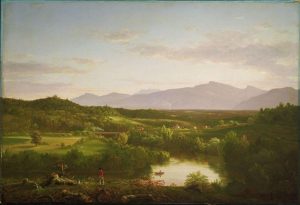 |
 |
| River in the Catskills. (1843). Oil on canvas. | View from Mount Holyoke, Northampton, Massachusetts, after a Thunderstorm-The Oxbow. (1836). |
One of the characteristics of Romantic landscapes is the use of scale to remind viewers of the smallness of human beings and their affairs. Cole’s famous painting of an “Oxbow” bend in the Connecticut River carries the eye out from an elevated perch over a vast plain as storm clouds gather menacingly from the left. No trace of human habitation blots the vista. Or does it? Can you find it? A minuscule implement in the lower right? How does the parasol put into positive the human presence which behold the vast panorama?
Cole’s work inspired several younger artists. Asher Brown Durant’s land and seascapes make especially dramatic use of almost spiritual shafts of light. On the left, the dank gloom of dense forests, tree trunks dwarfing the wandering hiker, is pierced by light. On the right, the wreckage of a ship are bathed in a dawn benediction.
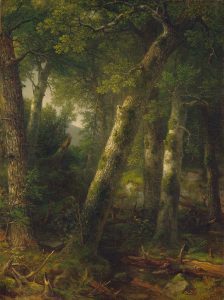 |
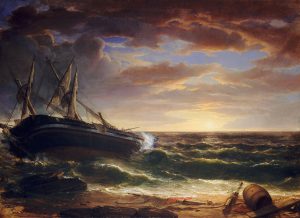 |
| Forest in the Morning Light. (1855). Oil on canvas. | The Stranded Ship. (1844). Oil on canvas. |
Frederic Edwin Church
As Thomas Cole’s only student, [Frederic Edwin Church] worked as a young man within the context of the Hudson River School. Soon he extended its romantic realism to treat unfamiliar, frequently awesome subjects with grander and more sensuous physical presence. His unusually extensive travels in the Americas, from the Arctic to equatorial South America, provided material for his most notable works, but he also painted views of Europe and the Middle East (Church, Frederic Edwin 2018).
Thomas Cole’s landscape visions are suffused with the Romantic spirit of the Sublime. Boiling with Nature’s potent menace, Storm in the Mountains nevertheless glazes the blasted tree trunk with light.
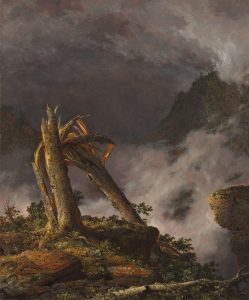 |
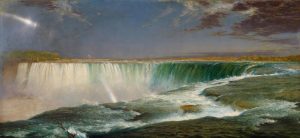 |
 |
| Storm in the Mountains. (1854). | Niagara. (1857). Oil on canvas. | Cotopaxi. (1862). Oil on canvas. |
Niagara places our perspective on the brink of destruction, the sublime force pulling us downward toward the rocks. In Cotopaxi, another waterfall seems to transport us into a primordial moment of time in which the earth itself seems to be newly born. The Sublime traveled well across the Atlantic.
References
Church, Frederic Edwin [Article]. (2018). Morgan, A. L. The Oxford Dictionary of American Art and Artists. Oxford, UK: Oxford University Press. https://www-oxfordreference-com.ezproxy.bethel.edu/display/10.1093/acref/9780191807671.001.0001/acref-9780191807671-e-267?rskey=waAbDU&result=4
Church, Frederic Edwin. (1862). Cotopaxi [Painting]. Detroit, MI: Detroit Institute of Arts. https://dia.org/collection/cotopaxi-37907
Church, F. E. (1857). Niagara. [Painting]. Washington, D.C.: Corcoran Gallery of Art. AN 76.15. https://www.nga.gov/artworks/166436-niagara
Church, F. E. (1854). Storm in the Mountains. [Painting]. Cleveland, OH: Cleveland Museum of Art. AN 1969.52 https://www.clevelandart.org/art/1969.52
Cole, T. (c 1830s). Indians Viewing Landscape [Painting]. Private Collection. WikiArt https://www.wikiart.org/en/thomas-cole/indians-viewing-landscape
Cole, T. (1843). River in the Catskills [Painting]. Boston, MA: Museum of Fine Arts. Boston Museum of Fine Arts. https://collections.mfa.org/objects/33073/river-in-the-catskills?ctx=1afb629e-070b-4d43-a11d-965c0d563577&idx=6
Cole, T. (1836). View from Mount Holyoke, Northampton, Massachusetts, after a Thunderstorm—The Oxbow [Painting]. New York City, NY: Metropolitan Museum of Ar. ON 08.228 https://www.metmuseum.org/art/collection/search/10497
Durand, Asher Brown. (1859). The Catskills [Painting]. Baltimore, MD: The Walters Art Museum. https://art.thewalters.org/object/37.122/
Durand, A. B. (1855). Forest in the Morning Light [Painting]. Washington, DC: National Gallery of Art. AN 1978.6.2. https://www.nga.gov/artworks/56571-forest-morning-light
Durand, A. B. (1844). The Stranded Ship [Painting]. Washington, DC: National Gallery of Art. AN 2003.71.1. https://www.nga.gov/artworks/56571-forest-morning-light
Durand, A. B. (1844). The Stranded Ship [Painting]. Washington, DC: National Gallery of Art. AN 2003.71.1. Jstor https://www.jstor.org/stable/community.14819703
Hudson River School. [Article]. (2016). In I. Chilvers (Ed.), The Oxford Dictionary of Art and Artists. Oxford University Press. http://www.oxfordreference.com.ezproxy.bethel.edu/view/10.1093/acref/9780191782763.001.0001/acref-9780191782763-e-1173.
Miller, A. L. (2011). Cole, Thomas [Article]. In Marter, J. [Ed.]. The Grove Encyclopedia of Art. Oxford, UK: Oxford University Press. https://www.oxfordreference.com/view/10.1093/acref/9780195335798.001.0001/acref-9780195335798-e-407.
A) a reaction against Neo-Classical Reason that seeks to liberate the individual human imagination and embrace its passions, dreams, and irrational visions as sources of wisdom. B) as an aesthetic, a rejection of strict artistic rules and convention in favor of organic form and innovation. C) often, advocacy for folk traditions that have been despised by classical elites
an aesthetic effect in art in which the viewer or reader experiences awe, even fear in a representation that (safely!) carries the imagination into danger, terror, darkness, solitude, or infinity
a visual composition that represents outdoor scenery that may or may not include human structures. Often an exercise in perspective and depth of field, with receding zones: foreground, middle distance, and deep distance.
